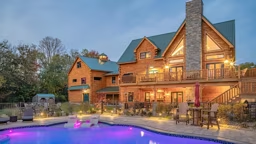
Photo: Colorado Timberframe
Adding on to any home takes forethought, but adding on to a full-log home can be tricky business. Not only do you need to ensure that the addition looks appropriate, you have to guarantee that the log connection will be structurally sound. There are a few important points to consider.
Age
For starters, the age of the existing log structure could come into play. The log profiles and connectors that manufacturers use today may be different than ones used a few decades ago. Not to mention that the original logs have been exposed to the elements, and the wood will take on the characteristics of that exposure. Trying to match new logs to old isn’t impossible, but it can be a challenge. You may have to modify your exterior finish a bit to achieve a cohesive look.
If trying to mesh antique logs with new is more than you want to take on, another approach is to use different materials altogether. Board-and-batt, cedar shake and even stone are all great options. The key is to incorporate some of these materials into the finishes of your existing house as well, like on a gable or along the foundation, to tie the whole thing together. This also gives you an opportunity to freshen up the look of the main part of the house.
Roofing
In any kind of home addition, you need to consider the roof. Pay close attention to where roof loads tie into log walls and make sure that the structure can support it.
For instance, if you’re simply inserting a 3-foot door that serves as a pass-through, you don’t have a lot to worry about. But if you are contemplating creating a bigger interior space by opening up that “end” wall by 10 to 12 feet, then you need to ensure the remaining structure can carry the load. Going perpendicular to the roof ridge may be more structurally feasible than going in line with it, and raising the roof on the addition will not only make the design look more intentional, it will help ease the load.
Planning Ahead
If you’re in the midst of planning to build a small log home with the goal of adding on in the future, two of the smartest things you can do to prepare is to design that addition as you’re planning your house and dig your foundation footers for that future expansion now. With the footers in place, you won’t have to excavate all the way around your house to tie it into the existing footer (required by code) later on. Plus, the footer for the addition will be uniform and at the right elevation to the existing house when you’re ready to start.
Utilities
Another thing you can do in advance is line up your electrical, plumbing and HVAC chases, whether they’re in the subfloor or a second-floor cavity, so that they can be easily connected to the addition when the time comes. And size your electrical panel accordingly: It’s easier to make the panel bigger on the front end than have to retrofit it to meet code later on.
See also: How to Expand and Renovate a Log Home











